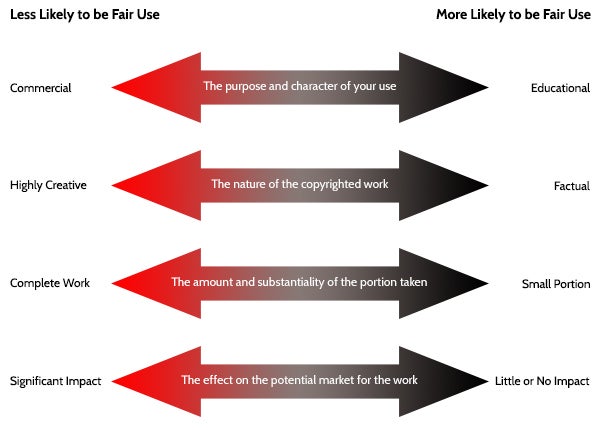What is Fair Use?
Fair use is a legal doctrine that allows the use of limited portions of copyrighted material under certain circumstances without getting permission from the copyright owner or paying any license fees. Fair use applies to all types of works, including text, images, video, and music. Some examples of fair uses are teaching, scholarship, research, criticism, commentary, news reporting, and parody.
What Are the Limits of Fair Use?
The most frequent question about fair use is how to determine how much of a work can be used legally. Unfortunately, the law and subsequent court cases do not provide a lot of guidance on which specific uses are fair and which are infringing. There is no formula, percentage, or amount of a work that is automatically deemed to be fair use. Rights holders and users of copyrighted materials do not always agree on whether a use is fair, so conflicts can arise, and a particular use could be challenged by the copyright holder. There are four factors that must be weighed and balanced to determine whether a given use is fair.
The Four Factors
Overview

Explanation
The Purpose and Character of the Use. Using material in a non-commercial environment and for a nonprofit educational purpose, such as criticism and commentary, is generally favored under the fair use analysis. Courts will also look to whether the use is "transformative," meaning that you did not just copy the original, but added new expression or meaning to it.
The Nature of the Copyrighted Work. Using material from primarily factual works is more likely to be considered fair use than using material from highly creative works, such as poems, films based on fictional stories, novels, music, etc.
The Amount and Substantiality of the Portion Used. There is no legal formula or rule to determine what percentage or amount of a copyrighted work you can use under the fair use doctrine. Using small portions from a copyrighted work is more likely to be considered fair use than using a larger portion of the work. A court would evaluate both how much of the work was used and its relationship to the full work.
The Effect of the Use on the Potential Market for or Value of the Copyrighted Work. A court will evaluate if and how the market value of the copyrighted work is affected by your use in determining whether it is fair. Note, however, that a court will look only to uses that could be a substitute for the original work, not potential market loss due to criticism of the work.
Steps for Making a Fair Use Decision
Fair use analysis is always done on a case-by-case basis and is subjective and fact specific. If you need to make a fair use decision, follow these steps:
- Learn the basics of copyright law and the fair use exception by reading our Introduction to Copyright page and this Fair Use page.
- As the user of the copyrighted materials, you are in the best position to do the fact-specific analysis required for fair use.
- Look carefully at each of the four fair use factors to determine where your use falls on the fair use scale.
- Use our Fair Use Evaluation Worksheet to provide a framework for your analysis.
- After considering all four factors, make a determination about whether your proposed use is likely to be fair, and document your analysis.
- If you are a member of the Georgetown community and are unsure of how to assess fair use in a particular situation, or if you believe your use may exceed fair use, contact librarycopyright@georgetown.edu.
Fair Use Cases
For an example of how a court analyzed the four fair use factors for course readings, read this 2016 district court opinion in the Georgia State reserves case. The court’s very detailed review goes into depth in its analysis of factors 2, 3, and 4 for each copyrighted work considered. The fair use analysis of individual works begins on page 20. The court’s analysis of the 48 readings in question continues through page 211. In a later proceeding in the same case, the court revisited some of its analysis of the four factors after receiving guidance from the Court of Appeals for the 11th Circuit. For examples of a finding of fair use and a finding of infringement, read these excerpts.
For examples of how the four factors have been weighed and balanced by different courts and which uses have been determined to be fair use by the courts, review the case summaries in the Fair Use Index (Copyright Office) or from Copyright & Fair Use (Stanford University). To find the full text of these cases, try Justia, Findlaw, a Google search, or a law library.
Resources
Web Sites
- Stanford University: Fair Use
- Center for Media and Social Impact: Fair Use
- Association of Research Library's Fair Use Fundamentals(infographic)
Books
- Crews, Kenneth D. Copyright Law for Librarians and Educators: Creative Strategies and Practical Solutions. 3rd ed. Chicago: American Library Association, 2012. Print. (Part III covers fair use)
- Aufderheide, Patricia and Peter Jaszi. Reclaiming Fair Use: How to Put Balance Back in Copyright. Chicago: University of Chicago Press, 2011. E-book. (Georgetown NetID required for login)
Videos
- The History of Fair Use (part of the CopyrightX series by Harvard Professor William Fisher, 40 minutes)
- Fair Use Today (part of the CopyrightX series by Harvard Professor William Fisher, 44 minutes)
Other Options
To explore other options for using third-party materials, visit our Using the Works of Others page.
